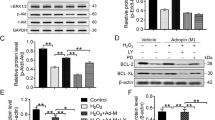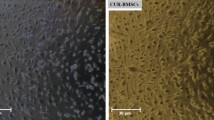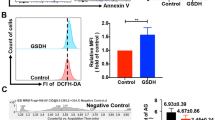Abstract
Bone mesenchymal stem cells (BMSCs) transplantation has been recognized as an effective method for the treatment of myocardial infarction (MI). However, its efficacy is always restricted by the low survival of transplanted BMSCs in the ischemic myocardium. The aim of this study was to investigate the effect of catalpol pre-treatment on the survival and vascular endothelial growth factor (VEGF) secretion of BMSCs under oxygen glucose deprivation (OGD) condition and their role in myocardial repair in a rat model of MI. According to our results, pre-treatment with catalpol enhanced VEGF secretion and survival of OGD-treated BMSCs. Moreover, the apoptosis of BMSCs induced by OGD was restrained by catalpol as evidenced by increased level of B-cell lymphoma-2 (Bcl-2) and decreased levels of BCL2-associated X (Bax) and cleaved caspase-3. In vivo study suggested that the survival of transplanted BMSCs was improved by catalpol pre-treatment. The myocardial fibrosis and apoptosis was further inhibited in catalpol pre-treated BMSCs group. Cardiac function detected by echocardiography was obviously improved by catalpol pre-treated BMSCs transplantation. Finally, angiogenesis and VEGF expression in the ischemic myocardium were significantly promoted in catalpol pre-treated BMSCs group. In conclusion, catalpol pre-treatment may facilitate the survival and VEGF secretion of BMSCs and improve their therapeutic effect on MI.






Similar content being viewed by others
References
Wu, Z., Chen, G., Zhang, J., Hua, Y., Li, J., Liu, B., Huang, A., Li, H., Chen, M., & Ou, C. (2017). Treatment of myocardial infarction with gene-modified mesenchymal stem cells in a small molecular hydrogel. Scientific Reports, 7, 15826.
Deluyker, D., Ferferieva, V., Driesen, R. B., Verboven, M., Lambrichts, I., & Bito, V. (2017). Pyridoxamine improves survival and limits cardiac dysfunction after MI. Scientific Reports, 7, 16010.
Elmadbouh, I., & Ashraf, M. (2017). Tadalafil, a long acting phosphodiesterase inhibitor, promotes bone marrow stem cell survival and their homing into ischemic myocardium for cardiac repair. Physiological Reports 5, e13480.
Amado, L. C., Saliaris, A. P., Schuleri, K. H., St John, M., Xie, J. S., Cattaneo, S., Durand, D. J., Fitton, T., Kuang, J. Q., Stewart, G., Lehrke, S., Baumgartner, W. W., Martin, B. J., Heldman, A. W., & Hare, J. M. (2005). Cardiac repair with intramyocardial injection of allogeneic mesenchymal stem cells after myocardial infarction. Proceedings of the National Academy of Sciences of the United States of America, 102, 11474–11479.
Zhang, G. W., Gu, T. X., Guan, X. Y., Sun, X. J., Qi, X., Li, X. Y., Wang, X. B., Lv, F., Yu, L., Jiang, D. Q., & Tang, R. (2015). HGF and IGF-1 promote protective effects of allogeneic BMSC transplantation in rabbit model of acute myocardial infarction. Cell Proliferation, 48, 661–670.
Gao, L. R., Pei, X. T., Ding, Q. A., Chen, Y., Zhang, N. K., Chen, H. Y., Wang, Z. G., Wang, Y. F., Zhu, Z. M., Li, T. C., Liu, H. L., Tong, Z. C., Yang, Y., Nan, X., Guo, F., Shen, J. L., Shen, Y. H., Zhang, J. J., Fei, Y. X., Xu, H. T., Wang, L. H., Tian, H. T., & Liu, D. Q. (2013). A critical challenge: Dosage-related efficacy and acute complication intracoronary injection of autologous bone marrow mesenchymal stem cells in acute myocardial infarction. International Journal of Cardiology, 168, 3191–3199.
Zhang, H., Hou, J. F., Shen, Y., Wang, W., Wei, Y. J., & Hu, S. (2010). Low level laser irradiation precondition to create friendly milieu of infarcted myocardium and enhance early survival of transplanted bone marrow cells. Journal of Cellular and Molecular Medicine, 14, 1975–1987.
Gao, X. R., Xu, H. J., Wang, L. F., Liu, C. B., & Yu, F. (2017). Mesenchymal stem cell transplantation carried in SVVYGLR modified self-assembling peptide promoted cardiac repair and angiogenesis after myocardial infarction. Biochemical and Biophysical Research Communications, 491, 112–118.
Carmeliet, P. (2005). Angiogenesis in life, disease and medicine. Nature, 438, 932–936.
Xia, J. B., Wu, H. Y., Lai, B. L., Zheng, L., Zhou, D. C., Chang, Z. S., Mao, C. Z., Liu, G. H., Park, K. S., Zhao, H., Kim, S. K., Song, G. H., Cai, D. Q., & Qi, X. F. (2017). Gene delivery of hypoxia-inducible VEGF targeting collagen effectively improves cardiac function after myocardial infarction. Scientific Reports, 7, 13273.
Gao, F., He, T., Wang, H., Yu, S., Yi, D., Liu, W., & Cai, Z. (2007). A promising strategy for the treatment of ischemic heart disease: Mesenchymal stem cell-mediated vascular endothelial growth factor gene transfer in rats. Canadian Journal of Cardiology, 23, 891–898.
Shieh, J. P., Cheng, K. C., Chung, H. H., Kerh, Y. F., Yeh, C. H., & Cheng, J. T. (2011). Plasma glucose lowering mechanisms of catalpol, an active principle from roots of Rehmannia glutinosa, in streptozotocin-induced diabetic rats. Journal of Agricultural and Food Chemistry, 59, 3747–3753.
Zhang, X., Zhang, A., Jiang, B., Bao, Y., Wang, J., & An, L. (2008). Further pharmacological evidence of the neuroprotective effect of catalpol from Rehmannia glutinosa. Phytomedicine, 15, 484–490.
Shen, C. Y., Jiang, J. G., Yang, L., Wang, D. W., & Zhu, W. (2017). Anti-ageing active ingredients from herbs and nutraceuticals used in traditional Chinese medicine: Pharmacological mechanisms and implications for drug discovery. British Journal of Pharmacology, 174, 1395–1425.
Wang, L., & Xue, G. B. (2018). Catalpol suppresses osteosarcoma cell proliferation through blocking epithelial-mesenchymal transition (EMT) and inducing apoptosis. Biochemical and Biophysical Research Communications, 495, 27–34.
Dong, W., Xian, Y., Yuan, W., Huifeng, Z., Tao, W., Zhiqiang, L., Shan, F., Ya, F., Hongli, W., Jinghuan, W., Lei, Q., Li, Z., & Hongyi, Q. (2016). Catalpol stimulates VEGF production via the JAK2/STAT3 pathway to improve angiogenesis in rats’ stroke model. Journal of Ethnopharmacology, 191, 169–179.
Hu, L. A., Sun, Y. K., Zhang, H. S., Zhang, J. G., & Hu, J. (2016). Catalpol inhibits apoptosis in hydrogen peroxide-induced cardiac myocytes through a mitochondrial-dependent caspase pathway. Bioscience Reports 36, e00348.
Chen, W., Li, X., Jia, L. Q., Wang, J., Zhang, L., Hou, D., & Ren, L. (2013). Neuroprotective activities of catalpol against CaMKII-dependent apoptosis induced by LPS in PC12 cells. British Journal of Pharmacology, 169, 1140–1152.
Li, L., Guan, Q., Dai, S., Wei, W., & Zhang, Y. (2017). Integrin beta1 increases stem cell survival and cardiac function after myocardial infarction. Frontiers in Pharmacology, 8, 135.
Minguell, J. J., & Erices, A. (2006). Mesenchymal stem cells and the treatment of cardiac disease. Experimental Biology and Medicine, 231, 39–49.
Schuleri, K. H., Feigenbaum, G. S., Centola, M., Weiss, E. S., Zimmet, J. M., Turney, J., Kellner, J., Zviman, M. M., Hatzistergos, K. E., Detrick, B., Conte, J. V., McNiece, I., Steenbergen, C., Lardo, A. C., & Hare, J. M. (2009). Autologous mesenchymal stem cells produce reverse remodelling in chronic ischaemic cardiomyopathy. European Heart Journal, 30, 2722–2732.
Liu, X., Hou, J., Shi, L., Chen, J., Sang, J., Hu, S., Cong, X., & Chen, X. (2009). Lysophosphatidic acid protects mesenchymal stem cells against ischemia-induced apoptosis in vivo. Stem Cells and Development, 18, 947–954.
Khan, I., Ali, A., Akhter, M. A., Naeem, N., Chotani, M. A., Mustafa, T., & Salim, A. (2016). Preconditioning of mesenchymal stem cells with 2,4-dinitrophenol improves cardiac function in infarcted rats. Life Sciences, 162, 60–69.
Meng, X., Li, J., Yu, M., Yang, J., Zheng, M., Zhang, J., Sun, C., Liang, H., & Liu, L. (2018). Transplantation of mesenchymal stem cells overexpressing IL10 attenuates cardiac impairments in rats with myocardial infarction. Journal of Cellular Physiology, 233, 587–595.
Kim, H. W., Haider, H. K., Jiang, S., & Ashraf, M. (2009). Ischemic preconditioning augments survival of stem cells via miR-210 expression by targeting caspase-8-associated protein 2. Journal of Biological Chemistry, 284, 33161–33168.
Wang, Z., An, L. J., Duan, Y. L., Li, Y. C., & Jiang, B. (2008). Catalpol protects rat pheochromocytoma cells against oxygen and glucose deprivation-induced injury. Neurological Research, 30, 106–112.
Hu, L., Sun, Y., & Hu, J. (2010). Catalpol inhibits apoptosis in hydrogen peroxide-induced endothelium by activating the PI3K/Akt signaling pathway and modulating expression of Bcl-2 and Bax. European Journal of Pharmacology, 628, 155–163.
Chen, C., Chen, Z., Xu, F., Zhu, C., Fang, F., Shu, S., Li, M., & Ling, C. (2013). Radio-protective effect of catalpol in cultured cells and mice. Journal of Radiation Research, 54, 76–82.
Cai, Q., Yao, Z., & Li, H. (2014). Catalpol promotes oligodendrocyte survival and oligodendrocyte progenitor differentiation via the Akt signaling pathway in rats with chronic cerebral hypoperfusion. Brain Research, 1560, 27–35.
Labi, V., Grespi, F., Baumgartner, F., & Villunger, A. (2008). Targeting the Bcl-2-regulated apoptosis pathway by BH3 mimetics: A breakthrough in anticancer therapy? Cell Death & Differentiation, 15, 977–987.
Porter, A. G., & Janicke, R. U. (1999). Emerging roles of caspase-3 in apoptosis. Cell Death & Differentiation, 6, 99–104.
Cohn, J. N., Ferrari, R., & Sharpe, N. (2000). Cardiac remodeling—Concepts and clinical implications: A consensus paper from an international forum on cardiac remodeling. Behalf of an International Forum on Cardiac Remodeling. Journal of the American College of Cardiology, 35, 569–582.
Abbate, A., Biondi-Zoccai, G. G., Bussani, R., Dobrina, A., Camilot, D., Feroce, F., Rossiello, R., Baldi, F., Silvestri, F., Biasucci, L. M., & Baldi, A. (2003). Increased myocardial apoptosis in patients with unfavorable left ventricular remodeling and early symptomatic post-infarction heart failure. Journal of the American College of Cardiology, 41, 753–760.
Rahbarghazi, R., Nassiri, S. M., Ahmadi, S. H., Mohammadi, E., Rabbani, S., Araghi, A., & Hosseinkhani, H. (2014). Dynamic induction of pro-angiogenic milieu after transplantation of marrow-derived mesenchymal stem cells in experimental myocardial infarction. International Journal of Cardiology, 173, 453–466.
Nor, J. E., Christensen, J., Mooney, D. J., & Polverini, P. J. (1999). Vascular endothelial growth factor (VEGF)-mediated angiogenesis is associated with enhanced endothelial cell survival and induction of Bcl-2 expression. The American Journal of Pathology, 154, 375–384.
Zhu, H. F., Wan, D., Luo, Y., Zhou, J. L., Chen, L., & Xu, X. Y. (2010). Catalpol increases brain angiogenesis and up-regulates VEGF and EPO in the rat after permanent middle cerebral artery occlusion. International Journal of Biological Sciences, 6, 443–453.
Author information
Authors and Affiliations
Corresponding author
Ethics declarations
Conflict of interest
We declare that there is no competing financial interest for this work.
Additional information
Handling Editor: Gen Suzuki
Rights and permissions
About this article
Cite this article
Ju, X., Xue, D., Wang, T. et al. Catalpol Promotes the Survival and VEGF Secretion of Bone Marrow-Derived Stem Cells and Their Role in Myocardial Repair After Myocardial Infarction in Rats. Cardiovasc Toxicol 18, 471–481 (2018). https://doi.org/10.1007/s12012-018-9460-4
Published:
Issue Date:
DOI: https://doi.org/10.1007/s12012-018-9460-4




